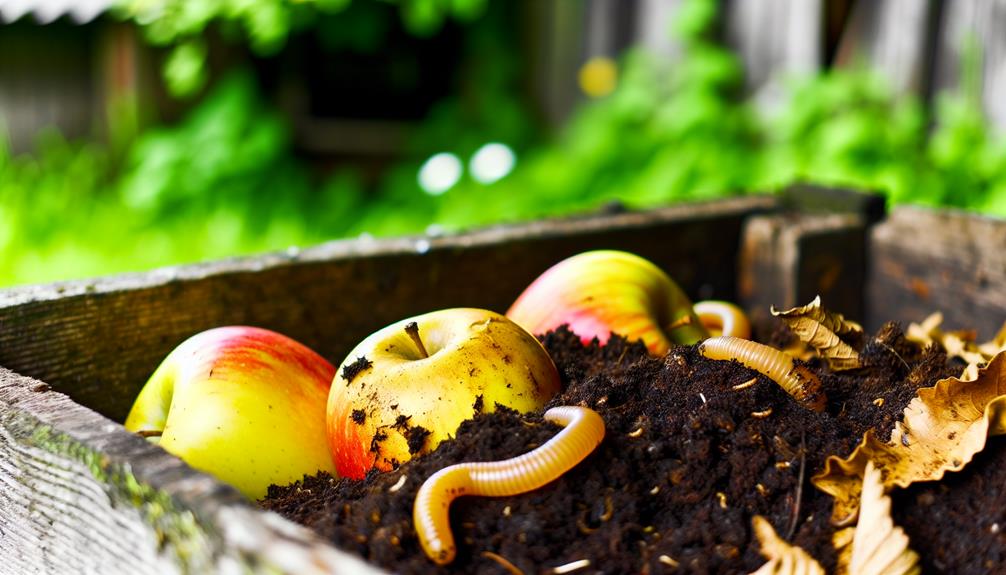

Yes, you can compost apple skins. They enrich your soil with essential nutrients like fiber, vitamin C, potassium, and antioxidants, promoting plant health. Start by rinsing and chopping the apple skins into smaller pieces for quicker decomposition. Make sure your compost pile is well-balanced with a mix of green and brown materials, aiming for a 3:1 ratio.
Turn the pile regularly to introduce oxygen, and keep it moist but not soggy. Be cautious not to add too many apple skins at once to avoid imbalance. Exploring further will enhance your composting skills and garden productivity.
Composting apple skins enriches your soil with essential nutrients and reduces kitchen waste. By adding apple skins to your compost pile, you’re effectively recycling organic material. This not only minimizes the waste that ends up in landfills but also produces rich, fertile compost for your garden.
To start, simply collect your apple skins in a container. Mix them into your compost bin along with other green and brown materials, like grass clippings and dry leaves, to maintain balance. Turn the pile regularly to speed up decomposition.
Apple skins break down relatively quickly, helping to create nutrient-rich compost that improves soil structure, retains moisture, and supports plant growth. Incorporating apple skins into your compost routine makes your gardening efforts more sustainable and effective.
Also Read: Can You Compost Agave?
Apple skins are packed with essential nutrients like fiber, vitamins, and antioxidants that benefit your compost and, ultimately, your garden. When you compost apple skins, you’re enriching your soil with these valuable components, which help plants grow strong and healthy.
Here are the key nutrients found in apple skins:
To maximize the benefits of these nutrients, you need to properly prepare the apple skins before adding them to your compost.

First, make sure the skins are free from stickers, wax, or any non-organic residues. Rinse them thoroughly under running water.
Next, chop the skins into smaller pieces to speed up the decomposition process. Smaller pieces increase the surface area, allowing microbes to break them down more efficiently.
If you have a large number of apple skins, consider spreading them out to dry for a day or two. This step reduces moisture content, preventing the compost from becoming too soggy.
Also Read: Can You Compost Bacon?
Once your apple skins are properly prepared, mix them evenly into your compost pile to guarantee balanced decomposition. This guarantees that the nutrients are distributed throughout the compost, aiding in the breakdown process.
To effectively add apple skins to your compost, follow these steps:
This method promotes efficient composting.
Maintaining a balanced compost pile is crucial for efficient decomposition and nutrient-rich compost. To achieve this, you need to balance green and brown materials.
Green materials, like apple skins, provide nitrogen, while brown materials, such as dried leaves or cardboard, supply carbon. A good rule of thumb is to aim for a ratio of roughly 3 parts brown to 1 part green.
Layer these materials and turn the pile regularly to guarantee proper aeration. Moisture is also key—your compost should feel like a damp sponge. If it’s too dry, add water; if it’s too wet, add more brown materials.
When composting apple skin, you might encounter mold and foul odors or notice a slow decomposition rate. To address these issues, you’ll need to verify the moisture levels and make sure a proper balance of green and brown materials.
Let’s examine the causes and solutions for these common problems.
Dealing with mold and foul odors in your compost pile can be frustrating, but understanding the causes helps you fix these issues quickly. Mold often appears due to excess moisture or lack of air. Foul odors indicate anaerobic conditions, meaning your compost isn’t getting enough oxygen.
Here’s how to tackle these common problems:
After addressing mold and foul odors, the next common issue you might encounter is a slow decomposition rate in your compost pile. To speed things up, you need to guarantee the right balance of green and brown materials, adequate moisture, and proper aeration. Here’s a quick troubleshooting guide:
| Issue | Solution |
|---|---|
| Low nitrogen (greens) | Add more kitchen scraps or fresh grass clippings |
| Too dry | Moisten the pile with water |
| Poor aeration | Turn the pile more frequently |
| Large particles | Chop or shred materials before adding |
Instead of composting all your apple skins, why not turn them into something useful?
You can make homemade apple cider vinegar, brew apple skin tea, or create tasty DIY apple skin chips.

These options not only reduce waste but also provide delicious and practical alternatives.
Turning your apple skins into homemade apple cider vinegar is a great way to reduce waste and create a versatile kitchen staple.
Here’s how you can do it:
After 1-2 weeks, strain out the solids and let the liquid ferment for another 3-4 weeks. You’ll have homemade apple cider vinegar ready for use in salads, cleaning, and more. Enjoy your eco-friendly creation!
For a cozy and flavorful drink, try making apple skin tea with the peels you might otherwise discard. Start by thoroughly washing the apple skins to remove any pesticides or wax.
Boil a pot of water and add the apple peels, letting them simmer for about 15-20 minutes. You can enhance the flavor by adding a cinnamon stick, a few cloves, or a bit of honey.
Once done, strain the liquid into a cup, discarding the solids. The resulting tea isn’t only tasty but also packed with nutrients like vitamin C and fiber. This simple method turns waste into a delightful beverage, making the most out of every part of the apple.
After enjoying a warm cup of apple skin tea, why not try making crispy apple skin chips for a healthy and delicious snack? It’s simple, quick, and a great way to minimize waste.
Here’s a step-by-step guide:
Enjoy your crunchy, nutritious snack!
Also Read: Can You Compost Azuki Beans?
As winter sets in, you might wonder how to effectively compost apple skins despite the cold weather. Start by insulating your compost bin to retain heat. You can wrap it in a tarp or use straw bales around the sides.
Add a mix of green and brown materials to maintain balance; apple skins are a great green component. Turn the pile occasionally to keep it aerated, which helps decomposition. If the pile freezes, don’t worry—it will restart once temperatures rise.
Use smaller pieces of apple skins to speed up the process. Keep the compost moist but not soggy, as too much water can slow down decomposition. With these tips, you can compost effectively even through the winter months.
Once your apple skin compost is ready, you’ll see how enriching it can be for your garden soil. Apple skins break down into nutrient-rich compost, which can greatly enhance soil health.
To make the most of it, follow these steps:
To sum up, composting apple skins is a straightforward way to enrich your compost pile. They add valuable nutrients and can be easily prepared by chopping into smaller pieces.
Make sure you balance green and brown materials to maintain a healthy compost. If issues arise, adjust moisture or aeration as needed. In winter, insulate your compost to keep it active. By following these tips, you’ll effectively enhance your soil with nutrient-rich apple skin compost.
